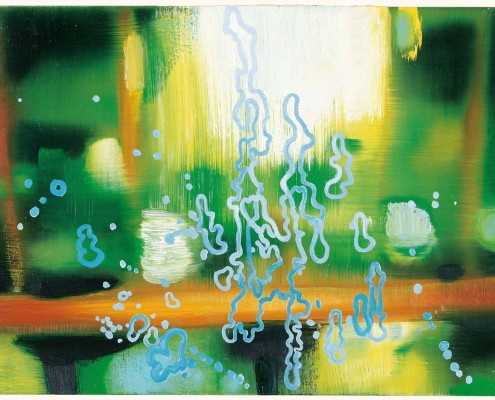Yuumi Domoto’s Exhibition of New Work
Yayoi Kojima, curator and writer
I visited Yuumi Domoto’s studio in the early afternoon on a hot day in August. Domoto was excited because this was her first solo show in four years. She said that she was feeling impatient because she had so many things she wanted to express, so many experiments she wanted to try. She told me, “I want to express everything I am thinking, even if the result is untidy.” How would it feel to want to do so much?
The theme of her new work is “solitude, love, and lies.” We no longer see the thick black lines that stand out clearly and boldly against an abstract background, some of the most prominent elements in her previous paintings. Blue lines are combined with expansive areas of color – red, yellow, and orange – that project a sense of dazzling light. Forms that seem splashed onto the surface have the appearance of dancing figures. Just what are they?
These forms are created by dripping paint on paper and moving the paper about by hand. The artist says she is fascinated by “the beauty of lines that arise from necessity” and has been making drawings of this type for a long time. To some extent, she has developed an ability to control the strength and weakness of the lines, but she leaves the forms that come about naturally just as they are. “I paint with the weight of the medium. I effectively employ both my own will and random effects.” The result is a self-portrait of the artist and appears to be take human form.
The figures created in this way on paper pass easily and quickly into the mind like images that suddenly stop moving due to malfunctioning of a television picture tube. We see a figure falling head down, a figure trying to avoid being blown away by a wind created by the momentum of the brush, and a group of figures sharing suspicious gossip. It is as if trees swaying in the wind were taking on human form.
The artist digests the figures resulting from this process in her own mind and paints them out once again in areas of color on canvas. In placing these figure-like images against colored backgrounds, Domoto intentionally creates a situation where no point comes into focus. In previous paintings featuring images with thick, black lines, she takes pleasure in the contrast between the strong lines and the background. In her new works, however, she departs from this method, which she finds “too fixed and intentional,” and experiments with compositions in which the image and background have a more flexible relationship, coming together as they move in and out of each other.
In a group of smaller works, she has painted views from ordinary, everyday life – a kitchen sink, a garden, city streets at night – as background. These are the kinds of scenes that we do not always perceive clearly. We often look at them absent-mindedly and even, at times, see them indistinctly through tears. Under such conditions, we may have a sense of these images melting in the eye. Such an impression may be particularly strong when one feels downhearted, distressed, or sad, perhaps at times when loneliness creeps into our lives. Domoto says, “Everyone is lonely at times but forgets when they are happy. It seems that I fall into the trap of loneliness when I feel unhappy.” She undoubtedly has a real understanding of such experiences at present due to accumulated experience. Realizing that “I want to paint the fact that, after all, life is wonderful,” she began making larger works. The light in these paintings is sometimes warm, sometimes harsh. Human figures and stories interact with backgrounds overflowing with various kinds of light.
On the way home after talking to Domoto, I suddenly thought of the words, “Warming Eggs under Black Clouds,” the title of a collection of essays by the poet Koike Masayo (published by Iwanami Shoten). In this book, Koike refers to a poem called “Ballad of Dark Clouds” by Gunter Grass. The poet observed a hen sitting on her eggs and never moving as dark clouds approach and pass by and depicted this scene in his poem. Koike concludes,
Just before the storm comes. Everyday life appears uncannily grotesque to our eyes, brimming with expectations of a thunderstorm that could strike in just a few minutes….I feel anxious as I read this poem, but this anxiety is an anxiety that I know well, one that belongs to me. As we warm the ominous eggs in our minds, we are the hens beneath the dark clouds.
As long as we are alive, we will be rained on. In everyday life, we are pressed for time, tell lies and try to conceal them, and often feel regret. Many people believe that this is the nature of reality. That is why, however, people have the capacity to love and to believe in love. Yuumi Domoto confronts dark clouds directly while continuing to warm her unique eggs, energetically representing this world in paint. Our hearts and minds respond to, and resonate with, her paintings.
“堂本右美の新作展に寄せて”
児島やよい(キュレーター/ライター)
8月の熱い昼下がり、堂本右美のアトリエを訪ねた。4年ぶりとなる新作展に向けて、堂本は気迫漲っていた。表現したいこと、新たに試みたいことがあり過ぎて「欲張っている」と言う。「まとまらなくてもいいから思っていることを全部出したい」と。そこまで表現したい思いとは何なのだろう。
「孤独と愛、そして嘘」が新作のテーマだ。今までの彼女の絵でとりわけ印象深かった、抽象的な背景にくっきりと、そしてどっしりと描かれる黒く太い線は姿を消している。赤、黄、オレンジの、まぶしい光のあふれる大きな色面に、水色の線が重なっている。しずくが飛び散るような、踊っている人の輪郭のような、いったい何の形…?
それは、紙に絵の具を垂らし、その紙を手で持って動かして描いたドローイングの線から生まれたものだった。「必然で起きる線の美しさ」に魅せられ、ずっとこのドローイングを続けている。ある程度、強弱をコントロールできるようになったが、自然にできる形を残している。「絵の具の重みで描くわけです。自分の意志と偶然性と、両方をうまく存在させる」。それはとりもなおさず、彼女の自画像であり、人間の姿にも見える。
紙の作品は、そうした手法で描かれた人の姿が、テレビで画像が乱れた一瞬、映像が静止して見えた時のように、予期せず、しかし心にスッと入ってくる。逆さまに落ちていく人。刷毛の勢いそのままに、ビュッと吹きすさぶ風に飛ばされそうになりながらじっと耐えている人。不吉なうわさ話をしている人たち。闇の中にざわめく樹さえも、人間の姿を写しているようだ。
こうして生まれた人間の姿を、自身の仲で消化した表現として、カンヴァスの色面の上に、もう一度描き込む。背景にも人物とおぼしき像にも、どちらにも焦点が合わない状況を、堂本は意図している。太い黒の線の図像を描いていたときには、背景との強いコントラストを楽しんでいた。しかし、その「決まりすぎて、意図的になりすぎる」手法から出て、背景と像がお互いに出たり入ったり、混じり合ったり、フレキシブルな関係性を示すような構成を試みている。そして、強くフラットな線から奥行きのある線へと変化してきたのである。
小さめの作品では、彼女が日常目にする光景――台所のシンクであったり、庭であったり、夜の街であったり――が背景として描かれる。そういえば、私たちはこうした光景をいつもはっきりと認識しているわけではなく、ボーッと眺めていたり、時には涙でにじんでいたりすると、眼の中で溶けていくような感覚として味わっている。それは特に、やるせない、せつない、悲しい、といった気持ちの時に強くなる気がする。孤独が忍び寄っている時、とも言えるだろうか。いや、堂本は言う。「人はみんな孤独をかかえているけれど、幸せな時には忘れている。自分が不幸だと思った時に、孤独の落とし穴に入り込むのだと思う」。彼女自ら、さまざまな経験をした今だからこそ、実感として身体のうちにあるのだろう。「それでも(After all)、人生は素晴らしい、ということを描きたい」と、取り組んだのが大きな作品だ。あたたかい光、きつい光、さまざまな光が満ちあふれる背景に重ね合わせる、人間の姿であり、物語である。
「黒雲の下で卵をあたためる」。詩人、小池昌代のエッセイ集のタイトル(岩波書店刊)である。堂本と話をした帰り道に、この言葉が浮かんだ。エッセイにはギュンター・グラスの詩「黒い雲のバラード」が引かれている。黒い雲が近づき、通り過ぎる中、じっと動かずに卵をあたためているめんどりを見ている詩人。そんな光景を描いた詩だ。小池はこう結ぶ。
「嵐が来る直前。日常は数分後に続く、雷雨の予感をいっぱいにためて、不気味にグロテスクに眼前にある。(中略)この詩を読むと不安になるが、その不安はわたしの良く知る、わたしのものでもある不安だ。不穏の卵をこころのなかであたためている、わたしもまた、黒雲の下のめんどりであった」。
生きていれば降り掛かる風雨。時間に追われ、嘘を隠して、悔いばかり残る日常。それが現実だと、多くの人が思っているだろう。だからこそ、人は愛し、愛を信じる力を持つ。堂本右美は、孤独の卵をあたためながら、黒雲をしっかりと見据えて、この世界を描いてやろうともがいている。そんな彼女の作品に、私の心はざわめき、共振していくのだ。






